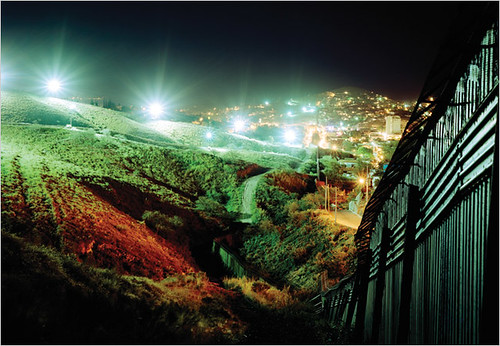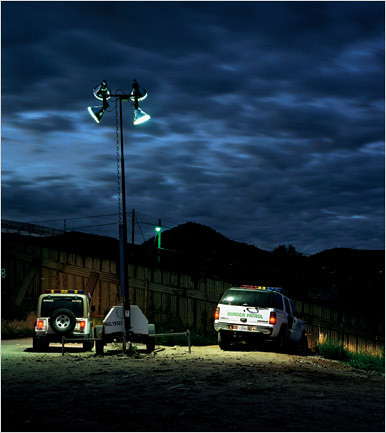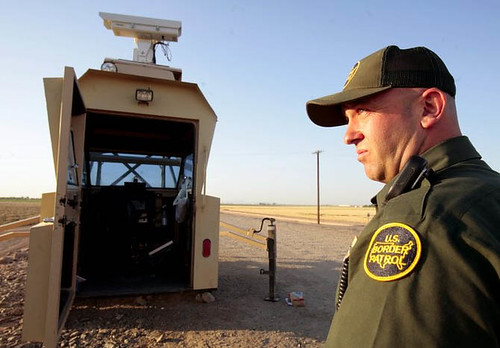Casting the SBINet
Historically, in the last decade, the techno surveillance programming the American government has used along the U.S./Mexican border has proven vastly inefficient both at preventing illegal immigration and as a financial investment. We’re all aware that illegal immigration has hardly slowed but rather has just been pushed out to lesser obvious migration routes, and while the U.S. government outsources border security to mega-corporations like Boeing, the cost analysis of these projects long after the contract has been awarded keeps climbing higher and higher.

[Image: Sept. 22., 5 a.m.: The border near Naco, Ariz., under the watchful glare of security lights. Photo by Simon Norfolk, The Border Dividing Arizona, New York Times.]
A recent article in Govexec.com reminds us that the older detection systems the Immigration Naturalization Service were using in 1997 (which consisted of sensors and cameras connected to Border Patrol databases), really only covered about 2 percent of the border, most of which either broke down in the weather or were never able to accurately distinguish between animals and humans. Furthermore, “auditors claimed that the General Services Administration's Federal Technology Service, which handled the purchase of the system, had been ripped off by contractors overcharging by tens of millions of dollars for equipment that in some cases didn't work.”

[Image: Sept. 19, 4 a.m.: Two towns called Nogales, one in Arizona (foreground) and one in Mexico. Photo by Simon Norfolk, The Border Dividing Arizona, New York Times. Inceidentally, astronomers working from observation centrrs along the border are now warning about light pollution that is emanating from the rash of stadium lights that are cropping in different pockets and ports of entry, making their jobs extremely difficult. You read a bit more here.]
So, as of 2004 the Department of Homeland Security discontinued development of this older system all the while, according to the same article, looking into the plausibility of building a “virtual fence” which would more effectively interconnect all of the sensors and cameras through more advanced technology under the plan America’s Shield Initiative. But, as we learn, “DHS repeatedly pushed back the release date for the contract solicitation, and then never released it. The next incarnation of border protection was the Secure Border Initiative, announced in 2005.”

[Image: Photo by Simon Norfolk, The Border Dividing Arizona, New York Times.]
One of the main components of a Secure Border Initiative is the SBINet, for whom Boeing Co. has been tasked with tying all of the existing border technologies together with a new kind of network that would also provide agents with situational awareness technology so that essentially everyone could be on the same page anywhere along the border when it comes to monitoring, reporting and acting on it. The contract period itself, according to one writer from Washington Technology, is “three years, with three additional one-year options.” With a minimum dollar amount of $2 million, the maximum is “the full panoply of supplies and services to provide 6,000 miles of secure U.S. border.” So far, DHS officials estimate a $7.6 billion price tag for SBINet to ensure operations up to 2011. “The estimate includes $5.1 billion for development and deployment of fencing, roads, barriers, sensors, and command, control and communications equipment, and $2.5 billion for integrated logistics and operations support," - better known as a ‘tactical infrastructure.’
However, the Government Accountability Office reported having worries that there weren’t enough oversight mechanisms or clearly defined deliverable milestones in the contract to safeguard against possible significant cost overruns. “As of December 2006, the SBINet program office had not fully defined and implemented critical acquisition processes, such as project planning, process and product quality assurance, measurement and analysis and requirements management,” the GAO said. Some analysts are saying the SBINet could grow as big as $30b.
Adding to these fears of an open-ended and somewhat vaguely defined border security contract with Boeing Co., the good folks at Mother Jones have also pointed out that oversight of the Secure Border Initiative, like the SBINet, has also been outsourced. Apparently, the DHS has turned over jurisdiction of making sure the U.S. taxpayers won’t be ripped off to consulting firm Booz Allen Hamilton, Inc. So, even though the U.S. government has a track record of being had by contractors hired to secure America’s borders, officials still refuse to perform their own vigilance.
But wait, it gets even better. Democratic Representative Henry Waxman from LA reported that this consulting firm is a regular business partner with Boeing. So, are we to believe that this pre-existing relationship will help ensure a more reliable oversight, or might it only prompt new fears that proper oversight will be virtually impossible without a more objective actor?
The SBINet is supposed to establish at least five separate projects by the end of 2008, with surveillance systems outside Tucson, Ariz., Yuma, N.M. and the Barry Goldwater mountain range. These projects are also supposed to create a “Common Operating Picture” (COP) for border patrol agents that would give them the type of surveillance and networking infrastructure that would allow them to share information across a greater field much more rapidly.

[Image: Border Patrol agent, as pictured in the Washington Post, photo by Melina Mara.]
I wrote earlier about “Project 28” near Sasabe where a Boeing-led team of contractors are developing a surveillance landscape prototype along a 28-mile stretch of territory along the U.S/Mexico border, an 8-month long pilot program that is supposedly testing the effectiveness of a “virtual fence” which in the end may be able to be cloned in other areas along the border where geographies and conditions make more traditional double and triple layered border fencing less appropriate.
So, recently, some new reports have come out about the progress of this test patch surveillatopia. It looks like Boeing is showing off a new mobile sensor tower that stands 98’ tall on a platform that can be easily moved. “The tower houses cameras, radar, wireless data access points, communications and computer equipment, and a tower security system.” The first tower is set to be deployed in Tucson, Arizona sometime in mid-April, but there are plans for a total of nine right now at the end of May. These towers will be configured with the COP to assist Border Patrol agents, who, as we read, will receive special “upgraded vehicles with rugged laptops and satellite phones” to create more mobile tactical communications units in the field. You can wtch a KVOA News 4 video here.

[Image: Boeing Successfully Tests First SBInet Mobile Sensor Tower, April 04, 2007, News Release.]
Hmmm….that sure doesn’t sound too impressive.
So, far, I think $368 million has gone into “Project 28” and this is what they have to show for it? Surely, I am being too skeptical.
Anyhow, I found in another news article that SBINet program manager Greg Giddens of DHS’ Customs and Border Protetion, has “recently issued a task order for a new Fence Laboratory in Texas.” Yup, a Fence Laboratory.
Done are the days of stacking some stones in sturdy piles and sticking spears into the ground. According to the article, which is well worth a read, the lab will include experts from the Energy Department’s Sandia National Laboratories, the Texas Transportation Department and Boeing Co. to determine an entire range of border fences that would respond and match the challenges of certain corresponding landscapes.

[Image: Border fence construction, via the New York Times.]
The Fence Laboratory will apparently study the capability of designing and deploying “intelligent fences” with all the techno-sensorial bells and whistles, that will help narrow the “sensor-to-sheriff” gap, according to the Border Calculus which we covered earlier. Let me quote the article at length to explain:
So, the nomadic fortress that I am always yipping and yapping about – you know, the crazy notion that there might exist one day a single universally connected border fence expanding around the planet along some contested geopolitical fault line – may have just taken one step closer to a more imminent future. India’s border guard outfit Sashastra Seema Bal (SSB) just launched a new satellite-based initiative to link all 582 of their outposts along the borders with Bhutan and Nepal, a state-of-the-art system that will in theory create a more united surveillance front minimizing the gaps in between the outposts and the border enforcement’s ability to respond to breaches anywhere along the line.
On the opposite side of the spectrum from the omniscience of these satellites peering down over the border, a small company has been granted a contract from DHS to continue manufacturing and refining an already existent product, one that we’ve actually heard of before: Spy rocks. That's right, they're back!

[Image: McQ aiding in development A new kind of wall, April 07, 2007.]
Apparently, a small Stafford county defense contractor company has been using "smart rocks", as they are called, to spy on insurgents in the Middle East. Soon, according to this news piece, McQ “may be making sensors to help the Department of Homeland Security stop illegal immigrants and narcotics traffickers” along the U.S./Mexico border.
Just last month, Jay M. Cohen, the Under Secretary for DHS’ Science and Technology division, gave a small contract to McQ to investigate its iScout technology. “The iScout is a small, low-cost, unattended ground sensor” that the company has already developed for the Army. A device the size of a deck of cards, it can be stashed in fake rocks and hidden in a tangle of weeds and branches, and is “"smart" enough to distinguish between human beings and animals, and wirelessly beam alerts that could alert a Predator drone to fly in and use its imaging and radar capabilities to pinpoint border violations.”
To round out the espionage fertility of this bugged border landscape, according to the Narcosphere, a Mexican newspaper on March 5, El Centro, “exposed information about a contract given by the U.S. State Department to Verint Technology Incorporated, a New York-based company, to spy on communications in Mexico.” The company is supposedly “a leading provider of analytic software solutions for communications interception, digital video security and surveillance.” This, from the dispatch, is part of a joint U.S./Mexican agenda to be able to spy on certain communications activity that could help apprehend illicit smuggler and drug trafficking activity.
Imagine one day all of this technology fitting into the border fence like some open-source superstructure; the border fence as the ultimate militarized architecture, covered in stadium lights, pain ray guns, infrared night-vision super scopes, assorted vibration sensors, video recognition gun mounts, motion detectors, communications interception systems, mobile towers, subterranean magnetometers, acoustic radars, billions of square inches monitored by a vast new geological spectrum of spy rocks that can distinguish a worm from a snake from a cow from a young child; all automatically controlled by some satellite that messages drones and blimps and outpost networks where the National Guard and Border Patrol agents’ hold game-pad like devices that indicate the movements of everything existing around the border within miles and miles of meticulously surveyed radius.
What if the fence became so structurally prominent that detention facilities were embedded into it so that apprehended migrants somehow ended up existing inside the fence itself, becoming literal inhabitants of the wall? What if the border fence became an entire global membrane for international surveillance, cross border espionage, and the spatial practice of hidden detention? Or, if future wars were fought with bomb proof border fences alone, butressed by armored Caterpillar D9 bulldozers that haul this flexible wall around while scraping along the earth and imprisoning anything in its path, pushing forward like a great wave of urbicidal steel across the geopolitical landscape?
This is outrageously far-fetched and cynical, I know, but I can't help to wonder - what is the future of the border fence when entire laboratories are dedicated to making it “intelligent”? When every bit of technology under the sun somehow merges together to create an uber barrier between nations, or, perhaps between the world? What will the evolution of the border fence tell us 100 years from now about the integrity of the nation state, or the fractured hypocrisy of a so-called global village?

[Image: Sept. 22., 5 a.m.: The border near Naco, Ariz., under the watchful glare of security lights. Photo by Simon Norfolk, The Border Dividing Arizona, New York Times.]
A recent article in Govexec.com reminds us that the older detection systems the Immigration Naturalization Service were using in 1997 (which consisted of sensors and cameras connected to Border Patrol databases), really only covered about 2 percent of the border, most of which either broke down in the weather or were never able to accurately distinguish between animals and humans. Furthermore, “auditors claimed that the General Services Administration's Federal Technology Service, which handled the purchase of the system, had been ripped off by contractors overcharging by tens of millions of dollars for equipment that in some cases didn't work.”

[Image: Sept. 19, 4 a.m.: Two towns called Nogales, one in Arizona (foreground) and one in Mexico. Photo by Simon Norfolk, The Border Dividing Arizona, New York Times. Inceidentally, astronomers working from observation centrrs along the border are now warning about light pollution that is emanating from the rash of stadium lights that are cropping in different pockets and ports of entry, making their jobs extremely difficult. You read a bit more here.]
So, as of 2004 the Department of Homeland Security discontinued development of this older system all the while, according to the same article, looking into the plausibility of building a “virtual fence” which would more effectively interconnect all of the sensors and cameras through more advanced technology under the plan America’s Shield Initiative. But, as we learn, “DHS repeatedly pushed back the release date for the contract solicitation, and then never released it. The next incarnation of border protection was the Secure Border Initiative, announced in 2005.”

[Image: Photo by Simon Norfolk, The Border Dividing Arizona, New York Times.]
One of the main components of a Secure Border Initiative is the SBINet, for whom Boeing Co. has been tasked with tying all of the existing border technologies together with a new kind of network that would also provide agents with situational awareness technology so that essentially everyone could be on the same page anywhere along the border when it comes to monitoring, reporting and acting on it. The contract period itself, according to one writer from Washington Technology, is “three years, with three additional one-year options.” With a minimum dollar amount of $2 million, the maximum is “the full panoply of supplies and services to provide 6,000 miles of secure U.S. border.” So far, DHS officials estimate a $7.6 billion price tag for SBINet to ensure operations up to 2011. “The estimate includes $5.1 billion for development and deployment of fencing, roads, barriers, sensors, and command, control and communications equipment, and $2.5 billion for integrated logistics and operations support," - better known as a ‘tactical infrastructure.’
However, the Government Accountability Office reported having worries that there weren’t enough oversight mechanisms or clearly defined deliverable milestones in the contract to safeguard against possible significant cost overruns. “As of December 2006, the SBINet program office had not fully defined and implemented critical acquisition processes, such as project planning, process and product quality assurance, measurement and analysis and requirements management,” the GAO said. Some analysts are saying the SBINet could grow as big as $30b.
Adding to these fears of an open-ended and somewhat vaguely defined border security contract with Boeing Co., the good folks at Mother Jones have also pointed out that oversight of the Secure Border Initiative, like the SBINet, has also been outsourced. Apparently, the DHS has turned over jurisdiction of making sure the U.S. taxpayers won’t be ripped off to consulting firm Booz Allen Hamilton, Inc. So, even though the U.S. government has a track record of being had by contractors hired to secure America’s borders, officials still refuse to perform their own vigilance.
But wait, it gets even better. Democratic Representative Henry Waxman from LA reported that this consulting firm is a regular business partner with Boeing. So, are we to believe that this pre-existing relationship will help ensure a more reliable oversight, or might it only prompt new fears that proper oversight will be virtually impossible without a more objective actor?
The SBINet is supposed to establish at least five separate projects by the end of 2008, with surveillance systems outside Tucson, Ariz., Yuma, N.M. and the Barry Goldwater mountain range. These projects are also supposed to create a “Common Operating Picture” (COP) for border patrol agents that would give them the type of surveillance and networking infrastructure that would allow them to share information across a greater field much more rapidly.

[Image: Border Patrol agent, as pictured in the Washington Post, photo by Melina Mara.]
I wrote earlier about “Project 28” near Sasabe where a Boeing-led team of contractors are developing a surveillance landscape prototype along a 28-mile stretch of territory along the U.S/Mexico border, an 8-month long pilot program that is supposedly testing the effectiveness of a “virtual fence” which in the end may be able to be cloned in other areas along the border where geographies and conditions make more traditional double and triple layered border fencing less appropriate.
So, recently, some new reports have come out about the progress of this test patch surveillatopia. It looks like Boeing is showing off a new mobile sensor tower that stands 98’ tall on a platform that can be easily moved. “The tower houses cameras, radar, wireless data access points, communications and computer equipment, and a tower security system.” The first tower is set to be deployed in Tucson, Arizona sometime in mid-April, but there are plans for a total of nine right now at the end of May. These towers will be configured with the COP to assist Border Patrol agents, who, as we read, will receive special “upgraded vehicles with rugged laptops and satellite phones” to create more mobile tactical communications units in the field. You can wtch a KVOA News 4 video here.

[Image: Boeing Successfully Tests First SBInet Mobile Sensor Tower, April 04, 2007, News Release.]
Hmmm….that sure doesn’t sound too impressive.
So, far, I think $368 million has gone into “Project 28” and this is what they have to show for it? Surely, I am being too skeptical.
Anyhow, I found in another news article that SBINet program manager Greg Giddens of DHS’ Customs and Border Protetion, has “recently issued a task order for a new Fence Laboratory in Texas.” Yup, a Fence Laboratory.
Done are the days of stacking some stones in sturdy piles and sticking spears into the ground. According to the article, which is well worth a read, the lab will include experts from the Energy Department’s Sandia National Laboratories, the Texas Transportation Department and Boeing Co. to determine an entire range of border fences that would respond and match the challenges of certain corresponding landscapes.

[Image: Border fence construction, via the New York Times.]
The Fence Laboratory will apparently study the capability of designing and deploying “intelligent fences” with all the techno-sensorial bells and whistles, that will help narrow the “sensor-to-sheriff” gap, according to the Border Calculus which we covered earlier. Let me quote the article at length to explain:
With the calculus, “officials analyze the distance in space and lag in time between an illegal immigrant’s entry and an imaginary line, beyond which the Border Patrol’s interception capability almost vanishes.
Among desolate mountains or in deserts along the border, that “sensor-to-sheriff” gap represented by the distance between the border and the imaginary line of migrant escape into the interior can stretch for miles and days of foot travel.
At border regions within cities, the imaginary line comes very close to the border, and a migrant who gets only a few blocks away from the border can hop a bus and ride to safety. “The clock starts when they cross the border, not when we find out about it,” Giddens said.
The sensor-to-sheriff gap drives the SBInet program managers’ effort to put advanced devices providing continual data streams into the hands of Border Patrol agents.
So, the nomadic fortress that I am always yipping and yapping about – you know, the crazy notion that there might exist one day a single universally connected border fence expanding around the planet along some contested geopolitical fault line – may have just taken one step closer to a more imminent future. India’s border guard outfit Sashastra Seema Bal (SSB) just launched a new satellite-based initiative to link all 582 of their outposts along the borders with Bhutan and Nepal, a state-of-the-art system that will in theory create a more united surveillance front minimizing the gaps in between the outposts and the border enforcement’s ability to respond to breaches anywhere along the line.
On the opposite side of the spectrum from the omniscience of these satellites peering down over the border, a small company has been granted a contract from DHS to continue manufacturing and refining an already existent product, one that we’ve actually heard of before: Spy rocks. That's right, they're back!

[Image: McQ aiding in development A new kind of wall, April 07, 2007.]
Apparently, a small Stafford county defense contractor company has been using "smart rocks", as they are called, to spy on insurgents in the Middle East. Soon, according to this news piece, McQ “may be making sensors to help the Department of Homeland Security stop illegal immigrants and narcotics traffickers” along the U.S./Mexico border.
Just last month, Jay M. Cohen, the Under Secretary for DHS’ Science and Technology division, gave a small contract to McQ to investigate its iScout technology. “The iScout is a small, low-cost, unattended ground sensor” that the company has already developed for the Army. A device the size of a deck of cards, it can be stashed in fake rocks and hidden in a tangle of weeds and branches, and is “"smart" enough to distinguish between human beings and animals, and wirelessly beam alerts that could alert a Predator drone to fly in and use its imaging and radar capabilities to pinpoint border violations.”
To round out the espionage fertility of this bugged border landscape, according to the Narcosphere, a Mexican newspaper on March 5, El Centro, “exposed information about a contract given by the U.S. State Department to Verint Technology Incorporated, a New York-based company, to spy on communications in Mexico.” The company is supposedly “a leading provider of analytic software solutions for communications interception, digital video security and surveillance.” This, from the dispatch, is part of a joint U.S./Mexican agenda to be able to spy on certain communications activity that could help apprehend illicit smuggler and drug trafficking activity.
Imagine one day all of this technology fitting into the border fence like some open-source superstructure; the border fence as the ultimate militarized architecture, covered in stadium lights, pain ray guns, infrared night-vision super scopes, assorted vibration sensors, video recognition gun mounts, motion detectors, communications interception systems, mobile towers, subterranean magnetometers, acoustic radars, billions of square inches monitored by a vast new geological spectrum of spy rocks that can distinguish a worm from a snake from a cow from a young child; all automatically controlled by some satellite that messages drones and blimps and outpost networks where the National Guard and Border Patrol agents’ hold game-pad like devices that indicate the movements of everything existing around the border within miles and miles of meticulously surveyed radius.
What if the fence became so structurally prominent that detention facilities were embedded into it so that apprehended migrants somehow ended up existing inside the fence itself, becoming literal inhabitants of the wall? What if the border fence became an entire global membrane for international surveillance, cross border espionage, and the spatial practice of hidden detention? Or, if future wars were fought with bomb proof border fences alone, butressed by armored Caterpillar D9 bulldozers that haul this flexible wall around while scraping along the earth and imprisoning anything in its path, pushing forward like a great wave of urbicidal steel across the geopolitical landscape?
This is outrageously far-fetched and cynical, I know, but I can't help to wonder - what is the future of the border fence when entire laboratories are dedicated to making it “intelligent”? When every bit of technology under the sun somehow merges together to create an uber barrier between nations, or, perhaps between the world? What will the evolution of the border fence tell us 100 years from now about the integrity of the nation state, or the fractured hypocrisy of a so-called global village?







4 Comments:
My first hand knowledge of surveillance and communication systems give me a great understanding of what this tower means to the SBINET venture. Mobile systems are actually cheaper to place in the field than permanent structures. As you know the southern border has many open areas. As one area is covered with equipment, the illegal crossers just move to an area without coverage. With mobile systems it is much harder to determine where the technology will be from day to day. Detterence is key for mobile systems like this. If people feel that it is useless to try to cross, they may decide not to try. As coverage of the border gets into full swing we will see a drop in actual illegal crossers as the arrest rate increases.
We still need however a valid visa program for the honest people trying to enter our country.
mike - please don't be so naive, people from other countries will find a way to come... put yourself in their shoes, hearing of a promise land guarded by the worlds finest technology must indeed be "the place" to live.
I live within the "security zone" and have watched this "war on the border" for 25 years. My thought... the more desparate people will always win, they have more at stake. technology will only allow our wonderful border guards to be even more lazy (if that's possible)... hmmm... maybe the intelligents rocks will replace the human guards, they move at about the same rate
Anonymous - I do agree that the more desperate the person the more the person will be willing to do to enter this country. I live in the "security zone" as well. The Visa program has to be overhauled. As the SBINET program testing is completed in "Project 28" I feel we will see less illegal migrants crossing that area. Deploying systems along the whole border at once is not feasible. We need a good test area so we don't end up with the problems they had with the ISIS program. I completely understand why people want to migrate to this country. At the same time, people that have been going through the process legally should not have to be dismayed by the people that come here illegaly.
As for the Border Patrol being lazy, I completely disagree. They are just overwhelmed and undermanned in some areas to deal with the vast migration coming in. Technology WILL enhance the border picture and allow the agents to better classify and engage the migrants. Therefore helping illiviate the influx.
I was a field engineer on the 97-04 Watchtower project that put the current surveillance towers in the ground. Licensed microwave, dual pedestal cameras (long range day and thermal imagining). A low wage LECA at sector could monitor 20 miles of the border and dispatch agents. With 80' towers, about $300k each. Up to 9/11, 250 of these sites were put in along the mexican border. Afterward, and to this day, very few put in the ground when we really need them. Boeing has been floundering trying to use off the shelf broadband wireless technology. We found that digital communications in the desert at 150F bad idea. Analog microwave gives low latency PTZ abilities and operates well in these conditions. With the money that is allocatd, we could have had the border virtually sealed up by 2004 with the best detection solution, human beings visually watching the border. With another 300 of these sites that cover 4 miles of the border each, the whole thing would be done by now at a final cost of 100 million. Most of us know it is still the best solution and technology, but unfortunately, the US was unwilling to employ individuals to maintain it giving it a bad rap.
Post a Comment
<< Home